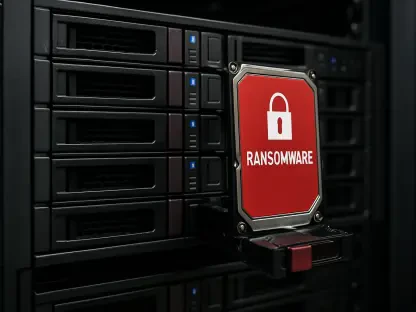In an era where digital infrastructure underpins nearly every aspect of business operations, the sophistication of ransomware attacks targeting cloud environments has reached alarming heights, posing unprecedented challenges for organizations. Cybercriminals are no longer satisfied with simply encrypting data on production systems; their strategies have evolved to strike at the very heart of recovery mechanisms. This alarming shift poses significant risks for organizations relying on cloud services, as attackers now aim to maximize disruption by targeting backup systems alongside primary environments. Reports from leading cloud security analyses highlight a disturbing trend where financially motivated threat actors are employing advanced tactics to cripple restoration efforts, forcing businesses into a corner with few options but to pay hefty ransoms. As these threats grow in complexity, understanding the changing landscape of ransomware in cloud ecosystems becomes critical for safeguarding sensitive data and maintaining operational continuity.
Emerging Strategies in Ransomware Attacks
Targeting Backup Infrastructure for Maximum Impact
As ransomware tactics advance, a particularly sinister trend has emerged with attackers zeroing in on backup infrastructure. Unlike traditional approaches that focused solely on encrypting production systems, modern threat actors, including advanced persistent threat (APT) groups like UNC3944 and UNC2165, are now systematically deleting backup routines and corrupting stored data. By altering user permissions to block recovery paths, these attackers ensure that organizations are left with no viable means to restore operations. This calculated move is designed to prolong downtime and create cascading failures across systems, significantly amplifying business disruption. The intent is clear: by eliminating restoration options, cybercriminals aim to pressure victims into quicker ransom payments. This evolution in strategy underscores a critical need for businesses to rethink how they protect not just their primary data but also the mechanisms meant to save them in a crisis, highlighting a gap in many current cybersecurity frameworks.
Prolonged Downtime as a Deliberate Tactic
Another alarming facet of these evolved ransomware strategies is the deliberate creation of extended downtime scenarios. When backup systems are compromised alongside production environments, recovery becomes a far more complex and time-consuming process. Threat actors exploit this vulnerability to exacerbate financial and operational impacts, knowing that prolonged outages can cripple a company’s ability to function and erode customer trust. This tactic shifts the goal of ransomware from mere data encryption to inflicting maximum disruption, often forcing organizations to comply with demands under intense pressure. The growing complexity of cyber recovery in such scenarios reveals a stark reality: attackers are adapting faster than many defenses can keep up. Businesses must now prioritize multi-layered strategies that anticipate these extended disruptions, ensuring that both primary and secondary systems are fortified against such dual-targeting approaches to mitigate the devastating effects of prolonged unavailability.
Persistent Vulnerabilities and Sophisticated Exploits
Credential Compromise and Misconfiguration Risks
Despite significant advancements in cybersecurity technology, foundational vulnerabilities such as credential compromise and misconfiguration remain dominant entry points for ransomware attacks in cloud environments. Studies indicate that nearly half of all breaches stem from stolen or leaked credentials, while close to a third are linked to improper system configurations. These persistent issues expose a critical oversight in many organizations, where basic security practices like robust authentication protocols and regular configuration audits are often neglected. The ease with which attackers exploit these weaknesses underscores an urgent need for enhanced identity security and posture management. As threat actors continue to capitalize on these gaps, businesses face increasing risks of unauthorized access leading to devastating ransomware incidents. Addressing these fundamental flaws is no longer optional but a prerequisite for building a resilient defense against the evolving landscape of cyber threats targeting cloud systems.
Exploitation of Trusted Cloud Platforms
Beyond basic vulnerabilities, cybercriminals are increasingly leveraging trusted cloud platforms for malicious purposes, adding a layer of sophistication to their attacks. Services like Google Drive and Dropbox, widely regarded as safe, are now being misused to host decoy files that appear harmless but trigger malware downloads in the background. This tactic complicates defense strategies, as distinguishing between legitimate and malicious content on such platforms becomes a formidable challenge. Attackers exploit the inherent trust users place in these services, often bypassing initial security checks with cleverly disguised files. This trend highlights a growing need for advanced threat detection mechanisms that can scrutinize content even on reputable platforms. As ransomware perpetrators refine their methods to blend into trusted digital ecosystems, organizations must adapt by implementing stricter access controls and real-time monitoring to prevent these covert attacks from taking root and causing widespread damage.
State-Aligned Threats and Advanced Techniques
State-aligned threat groups add another dimension to the ransomware challenge, with entities like the North Korea-linked UNC4899 demonstrating remarkable precision in targeting cloud-hosted cryptocurrency platforms. By employing social engineering and session cookie theft, these actors bypass multifactor authentication (MFA), often disabling and re-enabling it to evade detection. Such tactics reveal a high level of awareness and adaptability, as attackers tailor their methods to counter existing security measures. This sophistication poses a significant risk to industries handling high-value digital assets, where a single breach can result in substantial losses. The ability of these groups to operate with such stealth and accuracy emphasizes the importance of staying ahead of evolving threats through continuous updates to security protocols. Organizations must remain vigilant, investing in advanced training and technologies to combat these state-sponsored actors who are redefining the boundaries of cyber warfare in cloud environments.
Navigating the Future of Cloud Security
Strengthening Defenses Against Dual-Targeting
Looking back, the battle against ransomware in cloud environments revealed a pivotal shift as attackers began targeting both production and backup systems with ruthless efficiency. Reflecting on past incidents, it became evident that fortifying defenses required a dual focus on safeguarding primary data and ensuring the integrity of recovery mechanisms. A key lesson was the importance of isolating backup systems from production environments to prevent simultaneous compromise. Implementing immutable storage solutions emerged as a vital step, ensuring that data remained untouchable even during an attack. Organizations that adopted these measures often mitigated the worst impacts of dual-targeting strategies, underscoring the value of proactive planning. As threats grew more complex, the emphasis on regular testing of recovery processes proved indispensable, allowing businesses to identify weaknesses before attackers could exploit them, thereby reducing the risk of prolonged downtime in critical situations.
Adopting Proactive Security Measures
In retrospect, one of the most effective responses to the escalating ransomware threats was the widespread adoption of proactive security measures tailored to cloud ecosystems. Solutions like enhanced authentication for developer tools, such as the Verified CRX Upload process for Chrome extensions introduced earlier, added crucial layers of protection against malicious updates. Historical analysis showed that prioritizing identity security and addressing misconfigurations significantly reduced the likelihood of initial access breaches. Staying vigilant against the misuse of trusted cloud services also became a cornerstone of defense strategies, with many organizations implementing advanced monitoring to detect anomalies in real time. Moving forward, businesses are encouraged to invest in comprehensive training programs that educate employees on recognizing social engineering tactics. By fostering a culture of security awareness and continuously updating defense mechanisms, companies can better prepare for future challenges in an ever-evolving threat landscape.









